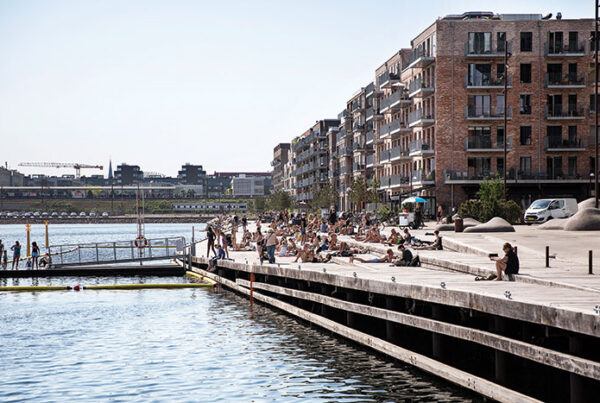
Canada’s largest cities like Calgary are moving quickly to shift from a largely carbon-based economy to a cleaner, more energy-efficient future as immigration has also surged. (Kyler Nixon/Unsplash)
Canada is moving forward with a climate plan that puts it on a path to exceed its existing 2030 emissions reduction targets and achieve net-zero emissions by 2050. A recent ULI webinar—with member speakers from ULI Toronto, ULI British Columbia, and ULI Alberta—addressed what leading real estate companies are doing to decarbonize their operations and development in anticipation of regulatory requirements.
Canada introduced its first-ever national climate plan—the Pan-Canadian Framework on Clean Growth and Climate Change (PCF)—in 2016. In December 2020, the government approved Healthy Environment and a Healthy Economy legislation that further strengthens that PCF climate plan with goals to further cut pollution, create more jobs, and launch other initiatives ranging from planting some 2 billion trees to increasing investment in renewables. The actions built into the climate plan are structured around a 10-year time frame.
“Giving this kind of timeline to businesses really gives the opportunity for people to be ready for this, while also creating that incentive towards long-term investment,” says Lisa Bate, global sustainability lead and advance strategy and senior principal at B+H Architects and moderator of the webinar.
The five pillars of the climate action plan are as follows:
Affordability: Make the places where people live and work more affordable by improving energy efficiency, cutting pollution, and creating jobs.
Accessibility for transportation and power in every community: Make clean, affordable transportation and power available in every community. Expand the supply of clean energy by increasing the focus on renewables, such as solar, wind, and geothermal, as well as next-generation energy and next-generation technology.
Engaging households: Addresses climate action at the household level, emphasizing the costs that households bear, and savings to be gained, by reducing pollution in areas such as food costs, housing, and health & wellness.
Strengthening Canada’s industrial advantage: Create economic growth while helping businesses reduce emissions—ultimately ensuring that the country continues to have good-paying, long-lasting jobs.
Embrace the power of nature to support healthier families and more resilient communities. Preserving nature is an important element of the plan, with specific actions that include supporting sustainable farming and planting 2 billion trees in degraded lands (from fire or pest infestations) and in urban forests.
Commercial Real Estate’s Role
“We need the commitments, the know-how, and the aligned action. All of this is just words until we actually look at where we need to make these impacts,” Bate says. Retrofits, for example, are a massive opportunity. Specifically, the Canada Infrastructure Bank (CIB) will invest $10 billion across five priority initiatives, including building retrofits, as part of its growth plan to build new infrastructure that will accelerate Canada’s transition to a low-carbon economy and strengthen economic growth. Canada’s Green Municipal Fund also is a $1 billion program that will have grants and loans available to help municipalities identify sustainable solutions.
The documentation for the PCF in 2016 and the more recent Healthy Environment and Economy provides “road maps” on how to move forward, and retrofits represent one starting point for the real estate industry, says Léo Lejeune, senior principal, architectural senior leader at Stantec in Calgary. For example, Calgary currently has a surplus of commercial office space, with vacancies in downtown Calgary fluctuating between 25 and 30 percent. “This presents a huge opportunity on what can be done with our buildings and how that impacts Canada’s climate action plan,” he says. There also is an opportunity to retrofit, renovate, and repurpose those buildings in a manner that achieves higher value for what is left behind, Lejeune says.
Post-secondary institutions also present another opportunity for retrofits, since many facilities were built when sustainability was not part of the conversation. For example, the University of Calgary has made great strides with a 30 percent reduction from its 2010 baseline in its emissions, despite a 20 percent growth in its student population. Like many institutions, the university has a goal to be carbon neutral by 2050. Similar to the commercial sector’s, the University of Calgary’s focus is on retrofits, as well as working toward net zero in new builds, Lejeune notes.
“A lot of this change is being driven by the impact of students and the voice of the students. They’re starting to put their money where their mouth is, in terms of where they make their decisions to study and this, of course, drives the economy,” he says. Universities are now measuring themselves against a sustainability metric. Universities in Canada have seen a surge of applications, and “their ambitions are making a difference, and it’s helping serve as a draw for students to attend,” said Lejuene.
Collaboration and Innovation
Collaboration will be an important piece to drive action in the government’s climate plan. The legislation does leave the door open for how the climate plan can evolve in regionally specific environments, which is an important consideration due to the country’s many Indigenous communities, adds Eladia Smoke, principal architect, Smoke Architecture Inc. “We have a tremendous diversity across Canada and the solutions for each region will probably grow out of developing partnerships and relationships with the Indigenous peoples in those territories specifically,” she says. In fact, the Climate Plan talks specifically about how Indigenous peoples will lead and contribute to Canada’s actions on climate change in the coming years, she adds.
The institutional owner community in Canada is ready to move forward, as is evident from the likes of Ivanhoé Cambridge, Cadillac Fairview, Oxford Properties Group, and others that have already emerged as global leaders in sustainability, says Amy Erixon, global president, Investment Management at Avison & Young. “On top of that, I think that we have an ecosystem here that is really going to make this transition for the building industry pretty straightforward,” she says.
The commercial real estate industry can learn from what is being done across other platforms. For example, the federal government moved its entire footprint to renewable energy by 2019, which was ahead of its original target of 2021. Its process included negotiating direct purchase agreements with every province. “So, it’s definitely doable, and the learning about how they went about it is a good first place to start,” she says.
The Canada Green Build Council also stepped up to run a net-zero pilot program. There are more than 50 certified net-zero buildings in Canada today and another 125 or so working their way through the certification process. In addition, several hundred projects are in the pipeline with owners that are “kicking the tires” and learning about the system, Erixon notes. “The building owner community believes that this is inevitable. It’s something that we need to understand, know about, and get in front of, and I feel that the Canadian community has really embraced it,” she says.
Real estate stakeholders also are looking at climate action through an important financial lens. For example, Canada’s largest community credit union, Vancity, is currently working with community partners on a pilot to test new underwriting criteria and lending terms that would encourage early integration of green and low-carbon design considerations in the real estate financing process. Two of the elements that need to be tested are amortization period and property valuation that affects loan-to-value ratio, notes Christine Bergeron, president and CEO of Vancity. “In order to shift how risk is assessed, we need to be able to establish some proof points that the new approach is having the desired impact,” she adds.
Industry players recognize that heavy lifting still lies ahead. The province of Ontario, for example, has some unique challenges, one of which is the cold winter weather and reliance on natural gas for heating. Converting to a net-zero environment involves moving everything to electricity. Yet Ontario’s electric grid currently uses significantly fewer renewable sources as compared with the rest of Canada. The ability for owners to use offsets, including direct renewable energy contracts and access to carbon tax credits for cost mitigation on retrofits, also is difficult to do in Ontario. “So, we’ve got some work to do with Premier [Doug Ford] to try and help him to understand that we’re trying to be part of the solution and getting that ability so that we can drive more renewable into the Ontario grid,” she says.



